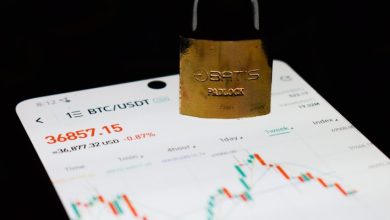The Risks of Centralized Exchanges: How to Stay Safe

- Understanding the vulnerabilities of centralized exchanges
- Tips for protecting your assets on centralized platforms
- The dangers of storing all your funds in one place
- Security measures to consider when using centralized exchanges
- What to do in case of a centralized exchange hack
- Balancing convenience with security when using centralized exchanges
Understanding the vulnerabilities of centralized exchanges
Centralized exchanges are often targeted by hackers due to the centralized nature of their operations. This vulnerability stems from the fact that all user funds are pooled together on the exchange, making them a prime target for cyber attacks. When a centralized exchange is hacked, it can result in significant financial losses for users who have their funds stored on the platform.
Another vulnerability of centralized exchanges is the risk of insider threats. Employees of the exchange may have access to sensitive information and user funds, making them potential targets for internal fraud. This type of threat can be difficult to detect and prevent, putting users at risk of losing their funds.
Furthermore, centralized exchanges are subject to regulatory scrutiny and government intervention, which can impact the security and stability of the platform. In some cases, exchanges may be forced to comply with regulatory requirements that could compromise user privacy and security.
It is essential for users to be aware of these vulnerabilities and take steps to protect their funds when using centralized exchanges. By understanding the risks involved, users can make informed decisions about where to store their funds and how to mitigate potential threats.
Tips for protecting your assets on centralized platforms
When using centralized platforms, it is crucial to take steps to protect your assets from potential risks. Here are some tips to help you safeguard your investments:
- Enable two-factor authentication (2FA) whenever possible to add an extra layer of security to your account.
- Avoid storing large amounts of cryptocurrency on exchanges for extended periods. Transfer funds to a secure wallet that you control.
- Regularly monitor your account activity for any unauthorized transactions or suspicious behavior.
- Be cautious of phishing attempts and only use official links to access exchange platforms.
- Keep your login credentials confidential and use strong, unique passwords for each platform.
By following these tips, you can minimize the risks associated with centralized exchanges and protect your assets from potential threats.
The dangers of storing all your funds in one place
It is important to understand the risks associated with storing all your funds in one place, such as a centralized exchange. By keeping all your assets on a single platform, you are exposing yourself to a higher level of risk in the event of a security breach or other unforeseen circumstances.
Centralized exchanges are often targeted by hackers due to the large amount of funds they hold in one place. If a centralized exchange is compromised, you could potentially lose all your assets stored on that platform.
Diversifying your funds across multiple platforms can help mitigate this risk. By spreading your assets out, you are lessening the impact of a potential security breach on any one platform. This strategy can help safeguard your funds in the event of unforeseen events.
Furthermore, keeping all your funds in one place can also limit your ability to take advantage of different investment opportunities. By diversifying your holdings, you can access a wider range of assets and potentially increase your overall returns.
Security measures to consider when using centralized exchanges
When using centralized exchanges, it is crucial to consider various security measures to protect your assets and personal information. One key measure is to enable two-factor authentication (2FA) to add an extra layer of security to your account. Additionally, using a strong, unique password that is not easily guessable is essential to prevent unauthorized access to your account.
Another important security measure to consider is to regularly monitor your account for any suspicious activity. Keep an eye out for any unauthorized trades or withdrawals, and report them immediately to the exchange. It is also recommended to use a secure internet connection when accessing your account to avoid potential hacking attempts.
Furthermore, consider using a hardware wallet to store the majority of your funds instead of keeping them on the exchange. This adds an extra layer of security by keeping your assets offline and out of reach of potential hackers. Additionally, be cautious of phishing attempts and only click on links or emails from trusted sources.
Lastly, it is crucial to research and choose a reputable centralized exchange with a proven track record of security and reliability. Look for exchanges that have implemented security measures such as cold storage for funds, regular security audits, and insurance against hacking incidents. By following these security measures, you can help mitigate the risks associated with using centralized exchanges and protect your assets from potential threats.
What to do in case of a centralized exchange hack
In the unfortunate event of a centralized exchange hack, it is crucial to take immediate action to protect your assets and personal information. Here are some steps you can take to minimize the impact of a hack on your finances and digital security:
- **Contact the exchange:** The first thing you should do is contact the centralized exchange where the hack occurred. They may be able to provide you with information on the extent of the breach and what measures they are taking to address it.
- **Change your passwords:** It is important to change your passwords immediately to prevent any further unauthorized access to your account. Make sure to use strong, unique passwords for each of your online accounts.
- **Monitor your accounts:** Keep a close eye on your bank accounts, credit cards, and other financial accounts for any suspicious activity. Report any unauthorized transactions to your financial institution immediately.
- **Enable two-factor authentication:** Two-factor authentication adds an extra layer of security to your accounts by requiring a second form of verification in addition to your password. Make sure to enable this feature on all of your online accounts.
- **Consider using a hardware wallet:** To further protect your assets from future hacks, consider using a hardware wallet to store your cryptocurrencies offline. This can help prevent your funds from being accessed remotely.
By following these steps, you can help safeguard your assets and personal information in the event of a centralized exchange hack. It is essential to stay vigilant and proactive in protecting your digital assets from potential security threats.
Balancing convenience with security when using centralized exchanges
When using centralized exchanges, it is essential to strike a balance between convenience and security. While centralized exchanges offer ease of use and liquidity, they also present risks such as hacking and theft. To mitigate these risks, users should follow best practices such as enabling two-factor authentication, using strong and unique passwords, and only keeping a small portion of their funds on the exchange.
Additionally, users should be cautious about sharing personal information online and be wary of phishing attempts. It is important to research the reputation and security measures of a centralized exchange before depositing any funds. Regularly monitoring account activity and keeping software up to date can also help in staying safe while using centralized exchanges.
Ultimately, the key is to remain vigilant and proactive when engaging with centralized exchanges. By taking the necessary precautions and staying informed about the latest security threats, users can enjoy the convenience of centralized exchanges without compromising their assets.



